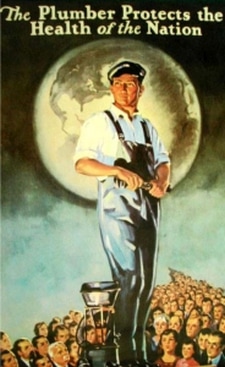 Throughout mankind’s history he has crafted piping from a variety of materials. Wooden pipes were some of the very earliest and he continued this practice right up into the twentieth century. As every school child knows, the Romans created pipe from terra cotta and lead. And, throughout the history of pipes, they have been employed to both supply civilizing communities with water to drink and to drain away their wastes. In the Weingarten edition of Plumbing A House we look at one of the latest supply variety: PEX, and, from time to time, yours truly will be leaving here, In The Pipe, his thoughts on other new arrivals and various other aspects of the changing world of modern day plumbing. According to the U. S. Geological Survey, the total amount of fresh water on earth (and that man has an opportunity to put into his pipes), comes to about 10.6 million cubic kilometers. If combined into a single droplet, this would produce a sphere with a diameter of about 272 kilometers. But, 99 percent of that sphere would be made up of ground water, a great deal of which is inaccessible. By contrast, the total volume from lakes and rivers, humankind’s main source, would produce a droplet of a mere 56 kilometers in diameter, not a pleasurable or reassuring thought. Other specialists (1) extrapolate that about only 0.5 percent of the world’s fresh water resources are available for the needs of populations and Eco-systems. Peter Gleick, of the Pacific Institute, in Oakland, CA, estimates that we humans require 13.2 gallons of clean water per day. Is it surprising, according to Peter, that in 2005, Americans were consuming 98 gallons per day? American Exceptionalism? Certainly not in Eco-folly. (The cup of coffee that someone might be drinking while reading these paragraphs requires approximately 140 liters of water to produce.) (Guilt? Guilt? Guilt?) Another reference to pipes: Boston was the first American city with a municipal waterworks, incorporated in 1652. The initial pipe line supplying water to the waterfront ran from Jamaica Pond to the Faneuil Hall area. And in 1795, 15 additional miles of three and five- inch bore hemlock water main was added, expanding the system, which was credited with lowering the city’s death rate. (2) Might this data have contributed to the saying: “The Plumber Protects the Health of the Nation”? (See poster above). Speaking of wooden water mains, if you were thrown into the calaboose, as late as the closing decade in the 19th Century, in the raucous gold mining/timbering town of Weaverville, CA, you might have “chosen” (in the case of a better word), while whiling away your forced vacation from your brethren, to ply your hand at employing the five-foot long manual auger bits to bore, from both ends, the hemlock and elm logs used for the city’s growing system of mains. “Me wonders” if those who proved most proficient at this chore ‘somehow’ had their bail denied versus those who demonstrated less aptitude. If you ever visit that quaint, now quite touristy enclave, you might wish to visit the basement of the Jake Jackson Museum to view these crude augers leaning in a corner of some original (iron) walls of the historic calaboose. And during your visit, behave yourself, or maybe………“Me surmises” also that if it were again, say, 1900, most of the present day patrons of the town’s very lively drinking establishment, The Diggin’s tavern, would prove remarkably proficient with those augers. (1.) WaterForTheWorld.Net (2.) National Drinking Water Clearing House, Kathy Jesperson
1 Comment
|
Author
Peter Hemp is a San Francisco East Bay residential plumber and plumbing author and former R & D steam vehicle plumber. His hobbies are ocean kayaking and touring the Left Coast by bicycle. Archives
September 2021
Categories |
|
|
Copyright © 2017 - 2022
All Rights Reserved
All Rights Reserved



 RSS Feed
RSS Feed